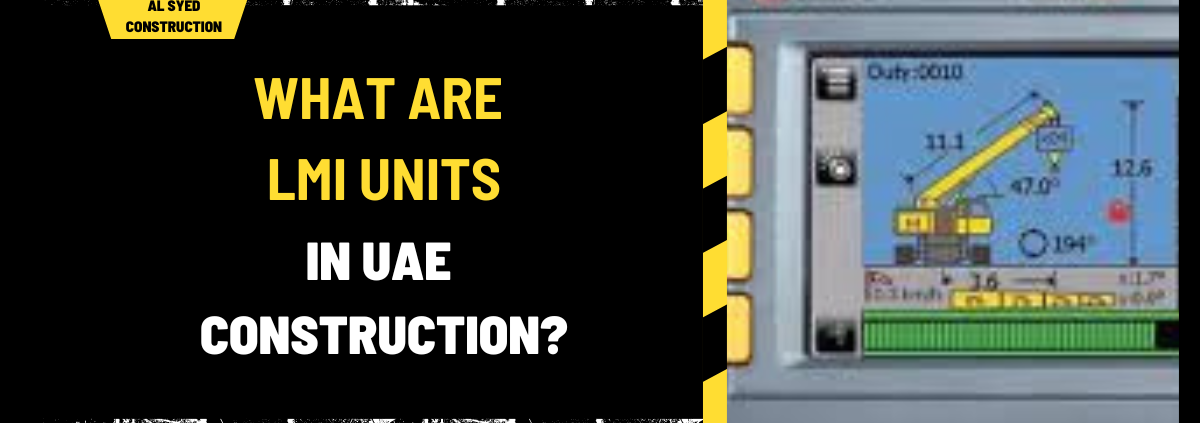What Are LMI Units in UAE Construction?
In the realm of construction, understanding the nuances of various measurement units is crucial for accurate project planning and execution. One such unit is the LMI unit. This article provides an in-depth examination of LMI units, including their definition, applications, and relevance in modern construction practices.
1. Definition of LMI Units
What Are LMI Units?
LMI units, or Linear Measurement Indicators, are a standardized method for measuring linear distances in construction projects. These units play a vital role in ensuring precision and consistency in the measurement of various structural components.
- Standardization: LMI units are standardized to provide uniformity in measurements across different projects and geographical locations.
- Precision: They offer high precision in linear measurement, essential for accurate construction and structural integrity.
Historical Context and Evolution
The concept of LMI units has evolved over time, adapting to advancements in technology and construction practices. Historically, measurements were often based on arbitrary or non-standardized units, leading to inconsistencies. The introduction of LMI units brought a level of standardization that greatly improved accuracy and efficiency.
2. Applications of LMI Units in Construction
Structural Engineering
In structural engineering, LMI units are used to measure critical dimensions of structural components, such as beams, columns, and slabs.
- Beam Measurements: Accurate measurement of beam lengths and widths is essential for ensuring that they can support the intended loads.
- Column Dimensions: Columns must be precisely measured to ensure they provide adequate support for the structure above.
Foundation Work
LMI units are also crucial in foundation work:
- Footings: Proper measurement of footings is necessary for achieving the required load distribution and stability.
- Foundation Depth: Ensuring the correct depth of foundations is vital for preventing settlement and ensuring the structural integrity of the building.
Building Layout
During the layout phase of construction, LMI units help in accurately marking and aligning various components:
- Wall Placement: Precise measurement is needed to ensure walls are straight and properly aligned.
- Room Dimensions: Accurate measurement of room dimensions ensures that architectural plans are correctly implemented.
3. Advantages of Using LMI Units
Enhanced Accuracy
The use of LMI units ensures enhanced accuracy in measurements:
- Error Reduction: Standardized units help reduce measurement errors, leading to more reliable construction outcomes.
- Consistency: Consistent use of LMI units across different projects ensures uniformity in measurement practices.
Improved Efficiency
LMI units contribute to improved efficiency in construction processes:
- Time Savings: Standardized measurements streamline the planning and execution phases, saving time on rework and corrections.
- Resource Management: Accurate measurements help in optimal resource management, reducing material waste and costs.
4. Integration with Modern Technology
Digital Measurement Tools
Modern technology has integrated LMI units with digital measurement tools, enhancing their functionality:
- Laser Distance Meters: These devices use LMI units to provide precise measurements quickly and efficiently.
- CAD Software: Computer-Aided Design (CAD) software utilizes LMI units to create detailed and accurate architectural plans.
BIM Systems
Building Information Modeling (BIM) systems leverage LMI units for comprehensive project planning:
- 3D Modeling: BIM systems use LMI units to create detailed 3D models of construction projects, improving visualization and coordination.
- Data Integration: LMI units are integrated into BIM systems to ensure accurate measurement data is available throughout the project lifecycle.
5. Challenges and Solutions
Common Challenges
Despite their advantages, the use of LMI units can present certain challenges:
- Measurement Errors: Even with standardized units, human errors or equipment inaccuracies can affect measurement outcomes.
- Unit Conversion: In projects involving international standards, unit conversion can lead to discrepancies if not managed properly.
Solutions
Addressing these challenges involves several strategies:
- Calibration and Maintenance: Regular calibration and maintenance of measurement tools help ensure accuracy.
- Training and Standards: Providing training for personnel and adhering to established measurement standards can mitigate errors and inconsistencies.
6. Future Trends and Innovations
Advancements in Measurement Technology
The future of LMI units in construction is likely to be influenced by ongoing advancements in measurement technology:
- Smart Sensors: The integration of smart sensors with LMI units could provide real-time measurement data and enhance accuracy.
- Automation: Automated measurement systems may further streamline the construction process, reducing the potential for human error.
Sustainability and Efficiency
Future innovations are also expected to focus on sustainability and efficiency:
- Eco-Friendly Materials: The use of LMI units in conjunction with eco-friendly materials can contribute to more sustainable construction practices.
- Energy Efficiency: Accurate measurements and efficient resource management can lead to energy savings and reduced environmental impact.
7. Conclusion
LMI units play a crucial role in modern construction by providing standardized, accurate measurements essential for structural integrity and efficiency. From structural engineering to foundation work and building layout, the use of LMI units ensures precise and consistent measurements. As technology continues to evolve, the integration of LMI units with digital tools and innovative systems will further enhance their effectiveness and applicability in the construction industry.




